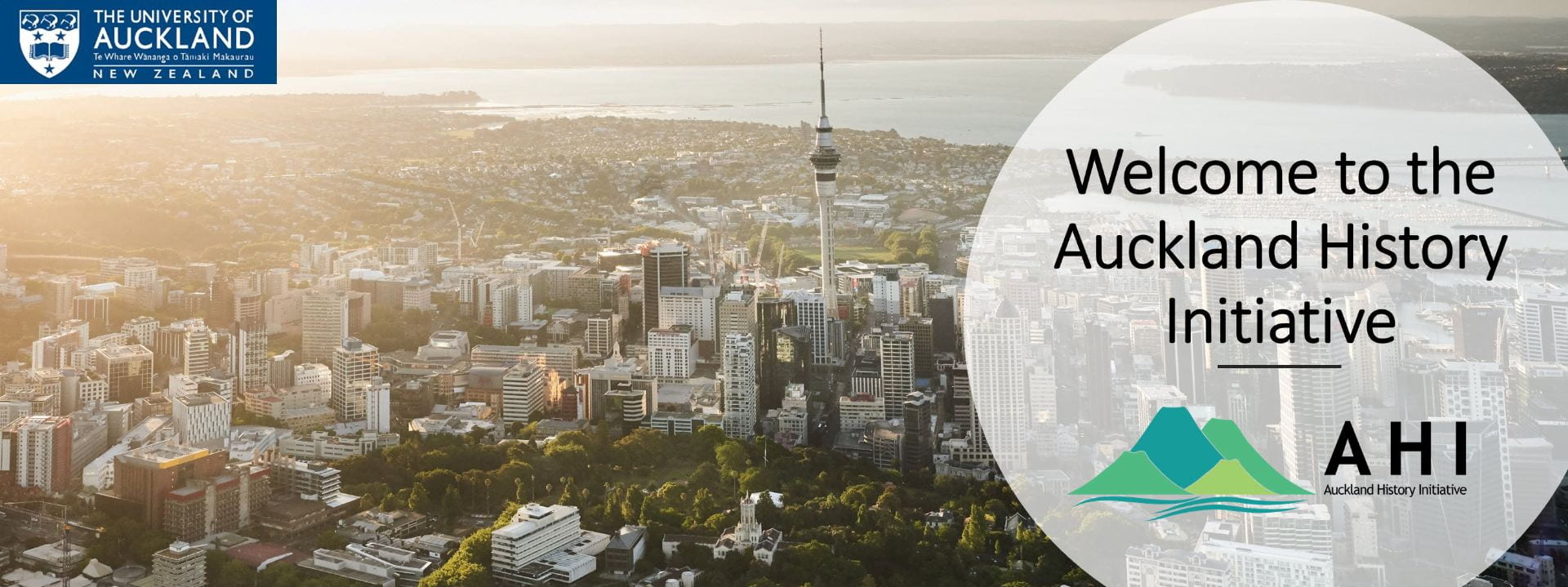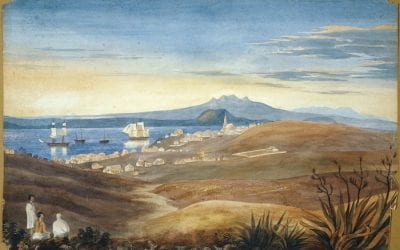
Ko te manu e kai ana i te miro, nōna te ngahere
Ko te manu e kai ana i te mātauranga, nōna te Ao
The bird who feeds on miro has the forest
The bird who feeds on knowledge has the world
Nau mai, haere mai ki Tāmaki Herenga Waka.
Ka nui te mihi ki a Ngāti Whātua Ōrākei te iwi mana whenua.
Tihei Mauri Ora!
AHI Mission Statement
Tāmaki Makaurau Auckland is situated amongst many volcanoes on an isthmus that is flanked by the Manukau and Waitematā harbours. The cones punctuate the skyline and the ocean is never far from view. These iconic features of the whenua have not only shaped the landscape but also the many peoples who have settled in this unique environment over centuries.
Welcome to the Auckland History Initiative. This research collaboration focuses on understanding the physical and cultural development of Tāmaki Makaurau Auckland as well as the wider Auckland region extending from Northland to the Waikato, and Auckland’s connections with international and global networks of trade, governance and culture.
In order to advance that understanding the AHI takes several approaches. These include:
- To increase students’ engagement with Auckland history, to stimulate their interest in and knowledge of their immediate surroundings and to enhance their employability
- To build relationships between the University of Auckland and Auckland’s Iwi and GLAM sector (Galleries, Libraries, Archives and Museums)
- To continue to establish relationships and research collaborations in the area of Tāmaki Makaurau Auckland history across disciplines and faculties at the University of Auckland
- To enhance public outreach by hosting public events focused on inviting discussion on the history of Tāmaki Makaurau Auckland
- To promote and support research into Tāmaki Makaurau Auckland history through an online platform and associated social media.

Ben Schrader presenting at the 2019 AHI Symposium.
Dr Ben Schrader: A Tribute
It was with great sadness that all of us at the AHI heard of the passing of Dr Ben Schrader on 19 April 2024.
Ben Schrader, who was only 59 years old, was New Zealand’s foremost urban historian and an unfailing supporter of the Auckland History Initiative.
Click to read more…
In his formative award-winning 2016 book, The Big Smoke, New Zealand Cities 1840-1920, Ben had noted that ‘more substantial city biographies are needed, particularly of Auckland’ (p.18).
It was not surprising then that, the following year, 2017, when a group in the University of Auckland History Department was arranging to meet to consider how to develop Auckland history, I received an email from Ben. He wrote that, at a recent meeting, Professor Raewyn Dalziel had alerted him to this: ‘She asked me whether this is the right moment for it to proceed and I made the case that it was.’ Ben went on to explain:
Every time I come up to Auckland it strikes me that this is the place where Aotearoa/NZ’s future is being made. This relates not only to the diverse composition of its peoples (or super diversity to use the buzz phrase), but also the myriad ways the city is changing to accommodate them: in terms of housing, transport, energy, economic and social relations, cultural production and so on. So naturally as an historian I look for the stories that help to explain how the past informs the present. While the city has some very good suburban histories there is nothing that relates a wider story – apart from Graham Bush’s civic histories of some time ago. I feel this is a real lack that should be addressed…. So the long and short of it is that I do think the moment is right to progress the Auckland history project idea and I hope it gets legs. As I said last week I’d be happy to provide input in some capacity if that would be helpful. (Email Schrader to Bryder, 8 December 2017)
The following year we invited Ben to be a keynote speaker at a two-day symposium planned for 15-16 April 2019, to which I got the usual enthusiastic response: ‘This sounds fabulous. I’d love to come and present.’ (Email Schrader to Bryder, 20 June 2018). The talk Ben chose to give at the symposium was: ‘Government House: the first ‘Auckland’ Building?’
The very same day the symposium ended, I received the following email from Ben:
Hi Linda,
Thanks for this. It was an honour to be invited to attend and be part of this terrific symposium. I’m still buzzing from the day.
I sometimes a feel bit lonely in my urban history pursuits in NZ so it was wonderful to see more people becoming engaged with the field and undertaking fascinating new areas of enquiry. I only wish I lived in Auckland and could be more closely involved.
I would really appreciate being kept in the loop and I hope you and others can continue to persuade the university what an important initiative it is. (Email Schrader to Bryder, 16 April 2019).
We also invited Ben to contribute an article for our website, which he did willingly and promptly. The article, posted on 1 October 2019, was headed, ‘Heritage is NOT history – or is it?’ This is an important discussion for historians to engage in. Ben himself was beginning to focus in his own studies on the history of urban conservation in New Zealand. In November 2022 he was a keynote speaker here at the University of Auckland at a joint conference of the Society of Architectural Historians, Australia and New Zealand and the Australasian Urban History/Planning History Group. His talk was: ‘Fabricating Identities: A Short History of Historic Preservation in Aotearoa New Zealand, 1890-1990’. In 2023 he was engaged in writing a history of historic preservation in Aotearoa New Zealand along with a fellow historian working in historical heritage and conservation Michael Kelly. Ben’s passing is a sad loss to history, heritage and conservation studies. Here at the AHI we hope to honour his memory and inspiration, and are considering ways of doing this.
Linda Bryder
9 May 2024
Read our AHI Summer Scholars work below
Prisoners to Patients – the Pre-Asylum State of Mental Health Care in Auckland
by Sasha Finer*
“A glance at the report of the inquest will show the evil of committing people of diseased mind to either the gaol or hospital. If any one ever required special treatment – medical, hygienic, or domestic – it is the lunatic.”
Opening the Door to the Private Spaces of Auckland’s Queer Communities
by Freiderike Voit*
In 1986, the Homosexual Law Reform Act legalised sex between men aged sixteen and over. This law change was the culmination of a decade and half of political discussion, and had mobilised New Zealanders to voice their opinions on homosexuality in over 1100 submissions to the Justice and Law Reform Select Committee.
Understanding historic Māori fluidity within Ngāti Te Ata Waiōhua: An outline
by Tommy de Silva*
What does the term ‘Tāmaki Makaurau’ mean? Some would argue that it means ‘Tāmaki of a hundred lovers’, while others would claim it means ‘Tāmaki desired by many’ or ‘Tāmaki the bride sought by a hundred’. No matter which meaning you prefer, they all clearly suggest that Tāmaki has long been a place sought after by many rōpū (groups).



